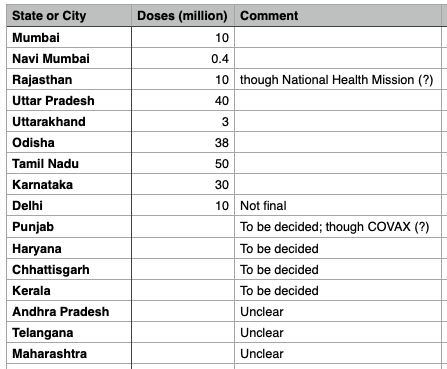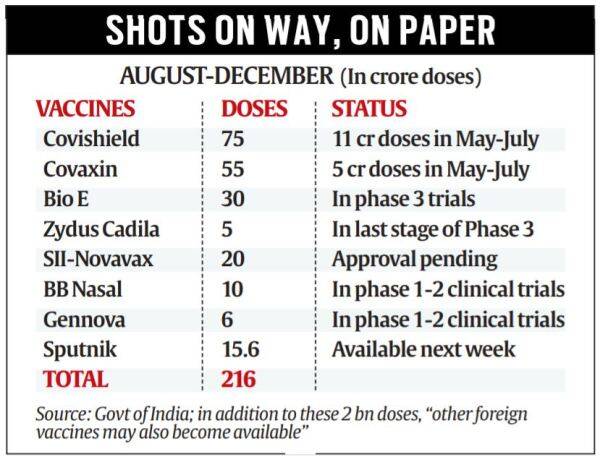This is the best estimate I could find of states and city municipal corporations ‘floating’ global tenders for vaccine acquisition.
The known numbers in the table total 191 million doses, which would vaccinate less than 100 million people.
It’s baffling, to me, to state governments, to commentators published in the media, that the national government refuses to import vaccines. After all, even the 27-member European Union, not even a single nation-state, has negotiated vaccine purchases as a bloc – securing a total of 1.5 billion shots from just Pfizer-Biontech for its population of 450 million people, to be delivered through 2023. That includes booster shots. One would think that this is one occasion when the country’d use its large population to its advantage. To use this analogy from an interview with two economists on the vaccination rollout:
Think about how McDonald’s does procurement. If you have 1000 McDonald’s stores across the length of the country, McDonald’s doesn’t say each of these 1000 independent franchisees should go and procure the potatoes and the oil themselves from the local daily market. The reason you have centralised procurement is precisely because it’s the most efficient way to do it.
The only possible reason I could think of the national government’s refusal is that importing vaccines would be a reversal of its messaging of being the ‘pharmacy of the world’, a claim made publicly as recently as mid-March 2021. I hope there is another reason to have states compete against one another.
Then there’s the claim made by a member of the national Covid task force that over two billion doses would be available between now and December 2021.
If those doses actually materialise, they would be enough to vaccinate the entire adult population and more.
Here are the manufacturers’ supposed estimates:
This Economic Times article has more details on the delivery schedule. I couldn’t find a definitive answer to whether the national government has committed to paying for these doses in advance, or according to a schedule – something that every major country worldwide has done.
As the graphic above states, these numbers don’t include imported vaccines. That is, the very doses that states and municipal corporations are ‘floating tenders’ for. So the country may well end up with more vaccine doses than it needs. State governments looking at this estimate have also probably wondered whether their procurement, costing a significant percentage of their state budgets, is redundant – once again, puzzling.
The well-known heart surgeon and hospital founder Devi Shetty also called for national vaccine procurement – and urgently:
… whatever has happened has happened; now for the vaccination the country has to buy together. So the bulk order will give you huge leverage in terms of negotiating for the best price. And unless these companies get money in advance, they won’t commit. We need at least five different vaccine manufacturers to come forward and say, okay, you give me the money, I will deliver you on this time.
We should just open our door for any country’s vaccine company to come here, set up the shop, and sell it to us. But they have to give it to us within the next three months. After that, it may not make that kind of a difference.
Q: Multiple states have floated global tenders, corporates have asked the government to liberalise vaccine import…
– Interview | We should be mentally prepared for COVID-19 pandemic to last until mid-2022: Devi Shetty
A: All of them should come together as one vaccine procuring agency.
To me the most convincing case is economic. Devi Shetty in the same interview:
So one day of lockdown, how much it is going to cost us; the vaccine is the cheapest solution we have today against COVID and we have to use it…
According to an April 2021 Barclays estimate, the economic cost of ‘sporadic lockdowns’ is USD 12.5 billion per week. Those are numbers, of course; this feature has a clearer picture of what that loss looks like for people.
(Part 3: The market for vaccines is not like the stock market)


